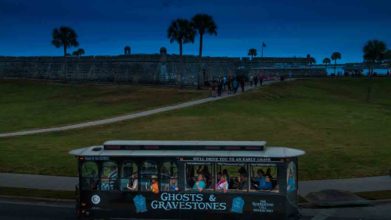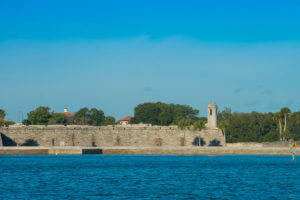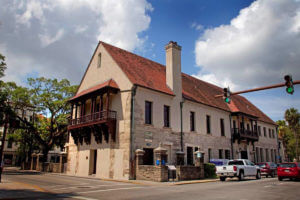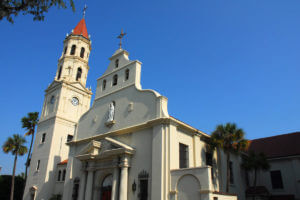Plaza de la Constitucion

Plaza de la Constitucion
Once a commercial center for various businesses in the Old City, the Plaza de la Constitucion is now home to an array of restaurants and shops. Its history began when a constitutional government was initiated in Spain. The area was used for the slave market and other commercial activities. Visitors to St. Augustine enjoy stopping at the Plaza for a peaceful rest and the lovely scenery.
Overlooking Matanzas Bay and the approach to the Bridge of Lions, the Plaza de la Constitucion has been a central part of public life in St. Augustine since the late 16th century. Flanked by several buildings dating from the colonial period, including the Government House and the Cathedral Basilica of St. Augustine, the plaza and its historic structure served as the commercial, governmental and spiritual heart of the city. The site for official ceremonies, it was also the public marketplace where ships docked at the nearby wharves sold their cargoes. Today, it is home to several monuments, memorials and landmarks as well as social gatherings throughout the year. A centerpiece of the city’s historic district, the plaza was designated a National Historic Landmark in 1970.
History of the Plaza
 One of a Kind
One of a Kind
Designated in a Royal Ordinance in 1573, the recreation area is the oldest public park in the United States. The ordinance required that the site have a rectangular shape based on the compass points with a length that was 1.5 times the width. The plaza received its name when an obelisk celebrating the Spanish Constitution was erected in 1812. After the monarchy was re-established the following year, King Ferdinand VII ordered all such monuments be destroyed. St. Augustine city leaders failed to comply with this and as a result, this is the only remaining monument of its kind in the world. The original streets of St. Augustine emanate from the plaza.
A Setting for Historic Events
The public square has been the setting for numerous historic events in the history of the city, Florida and the country. It was the site where representatives from both governments officially transferred control of Florida from Spain to the United States in 1821. The scene of numerous rallies leading up to the Civil War, the plaza was the location where Union naval officers reclaimed the city from the Confederacy in 1862. During the struggle for civil rights, the plaza, which once served as a slave market, was the setting for numerous peaceful protests. Robert Hayling, a young Black dentist, led the first protest on Labor Day in 1963. The following year, Dr. Martin Luther King was arrested there as he led another march.
Points of Interest on the Plaza
 Marketplace
Marketplace
The public marketplace at the eastern end of the plaza is a reconstruction of the one built in 1824. The four cannons were once used in the defense of the Castillo de San Marcos. A pre-1700 well has been designated an American Water Landmark.
War Memorials
Along with a Confederate war memorial, there are tributes to prisoners during the American Revolutionary War as well as soldiers who died in World War II, Korea and Vietnam. A statue commemorates Felix Varela, a Cuban-born Catholic priest known for his efforts to secure independence for his homeland during the 19th century. He spent his later years in St. Augustine.
St. Augustine Foot Soldiers Monument
Located near the southeast corner of the plaza is the St. Augustine Foot Soldiers Monument that honors the men and women who engaged in various forms of peaceful protest to advance civil rights. The 675-pound bronze sculpture by Brian Owens was unveiled in 2011 and depicts four figures of various ages and races.
Outdoor Events
The plaza hosts a variety of outdoor events, including festivals and concerts, throughout the year. It forms the backdrop for the Easter Parade, featuring locals promenading in their spring finery. From Memorial Day to Labor Day, the plaza’s gazebo is the setting for free Thursday night concerts. During the winter holiday season, 2 million tiny white lights trace the outline of the historic buildings and the branches of historic oak trees that surround the plaza.
Travel Tips
Bordered by St. George Street and King Street as well as Cathedral Place, the park is open to the public 24 hours a day free of charge. On-street, metered parking is available near the plaza. Parking is enforced from 8 a.m. until 5 p.m. Monday through Saturday, excluding national holidays. On Sunday, the city offers complimentary parking. For those taking the Old Town Trolley tour, hop off at Stop #15 to explore the area.
Nearby Attractions
 Government House
Government House
The Government House has been the site of official functions since 1598. The headquarters and residence of numerous colonial governors, the building served briefly as the capitol for the Territory of Florida. The lobby is used as a museum that hosts rotating exhibits.
 Cathedral Basilica of St. Augustine
Cathedral Basilica of St. Augustine
The oldest Catholic edifice in the city, the Cathedral Basilica of St. Augustine is an example of Spanish-inspired architecture. The walls are adorned with detailed frescoes depicting the early spread of Catholicism in the New World. The exquisite stained glass windows chronicle the work of St. Augustine of Hippo, the namesake of the church.
 Flagler College
Flagler College
Located in the former Gilded Age Ponce de Leon Hotel, Flagler College features opulent architectural details, frescoes and one of the largest collections of Tiffany stained glass windows. The National Historic Landmark is home to unique pieces, such as an onyx Thomas Edison clock and large ornate crystal chandeliers.
 Lightner Museum
Lightner Museum
Housed in the former Alcazar Hotel, the Lightner Museum is filled with interesting and beautiful Victorian-era antiques as well as sculptures, paintings and pieces of decorative art. Step back in time as you explore rooms restored to their former glory that provide the perfect backdrop for a wide assortment of priceless works.
 Ximenez-Fatio House
Ximenez-Fatio House
Built in 1798 as a merchant’s home and place of business, the Ximenez-Fatio House is a historic house museum that captures and preserves the first Florida tourism boom of the early 19th century. Staged in its role as a former boarding house, it is furnished with period pieces and family mementos.
FAQs
Why is the Plaza de la Constitución unique in United States history?
The Plaza de la Constitución is unique because it is one of the oldest public spaces in America, established by the Spanish in 1573. This makes it a focal point of St. Augustine, the nation’s oldest city, and a testament to the city’s rich Spanish colonial heritage.
What are some notable features of the Plaza de la Constitución?
Notable features of the Plaza include the Monument to the Spanish Constitution of 1812, which is one of the few remaining tributes to this constitution outside of Spain, and the public market that has been a commercial hub since the 1590s. The Plaza also boasts magnificent live oaks and a variety of historical buildings surrounding it.
Is the Plaza de la Constitución accessible to visitors year-round?
Yes, the Plaza is open to visitors year-round and is free to the public. It serves as a peaceful retreat in the heart of St. Augustine, where tourists and locals alike can enjoy the scenic views, historic ambiance, and lush greenery.





 Marketplace
Marketplace Government House
Government House Cathedral Basilica of St. Augustine
Cathedral Basilica of St. Augustine Flagler College
Flagler College Lightner Museum
Lightner Museum Ximenez-Fatio House
Ximenez-Fatio House